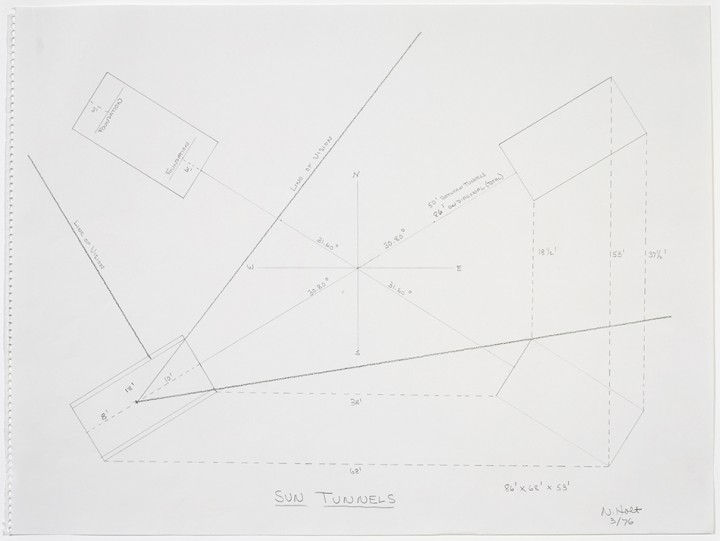Jennifer Padgett on Nancy Holt

Figure 1. Nancy Holt, Study for Sun Tunnels, 1976
Graphite and crayon on paper, 18 x 24 inches (45.7 x 61 cm)
Art © Nancy Holt/Licensed by VAGA, New York, NY
Nancy Holt
by Jennifer Padgett
Nancy Holt completed the drawing Study for Sun Tunnels (1976) during preparatory work for her site-specific installation Sun Tunnels (1973–76; fig. 1) in an area of Utah that is part of the Great Basin Desert. For the large-scale sculptural work, Holt placed four hollow concrete cylinders in an X-shaped arrangement, carefully oriented to create specific lines of vision that relate to both the surrounding desert land and larger astrological patterns. Holt—a central participant in the Land art movement that emerged in the late 1960s, which included artists such as Robert Smithson, Walter De Maria, and Michael Heizer—aimed to stimulate a greater awareness of the natural environment, and of human interaction with it, by using her work to focus selectively on elements such as the sun, moon, and stars. Sun Tunnels, like many other works of Land art, is a sculptural installation on a monumental scale that affects the viewer’s perception of both time and space.
On the summer and winter solstices, sight lines through the Sun Tunnels cylinders align with the position of the sun on the horizon, highlighting the cyclical quality of the solar year. The upper half of each tunnel is drilled with a series of variably sized holes, which allow natural light to stream into the interior. The holes were designed to correspond to the position and relative magnitude of the stars in a particular constellation, and their configuration is based on a complex calculation determined through the use of a helioscope, an instrument employed to observe the sun.1 The position and design of the cylinders required meticulous attention to astrological and geological conditions, and Holt collaborated extensively on the execution of the work. She worked with engineers, an astronomer, an astrophysicist, ditch diggers, and concrete pipe company workers, among many others, as the design, fabrication, and placement of the four cylinders—each weighing twenty-two tons—in a remote stretch of the Utah desert required considerable labor and logistical support.2
Holt’s construction drawing presents an abstracted vision of the sculpture, not re-creating the experience of viewing it but instead simplifying the sculptural installation into austere diagrammatic forms. In doing so, the drawing represents with mathematical precision the relationships among the work’s elements. The tunnels are indicated by four rectangles, viewed schematically from above as in an architectural plan. The viewer’s potential interactions with the objects are indicated by three straight lines, each marked “Line of vision,” projecting from the tunnel in the lower left corner of the sheet. She also noted the distances between the tunnels with dotted lines. Further expanding the context in which the tunnels are oriented, Holt registered their placement with respect to the cardinal directions, with two intersecting lines at the center of the drawing forming a compass marked by letters for north, south, east, and west at the respective endpoints. Two angled lines intersect this compass, indicating the axes along which the tunnels are placed; each line is marked with a notation of its degree of rotation from the cardinal axis, either 30.80˚ or 31.60˚.
The construction of the tunnels appears logical and orderly in the drawing, without the tension between man-made elements and nature that is a central concern in Holt’s site-specific work.3 The drawing offers only one view of the sculpture, while the actual experience of Sun Tunnels involves a more complex temporal and spatial process, as an individual can move toward, around, and even inside the giant concrete cylinders. In the presence of the sculptural work, the viewer is drawn into a greater consideration of the dynamic interplay between the tunnel structures and the surrounding landscape.
As diagrams, and as tools for plotting the relationships among various elements, this work and similar drawings were essential to the planning and execution of Holt’s large-scale sculptural installations. Beyond this practical function, the drawing illustrates a vital layer in Holt’s conception of Sun Tunnels and emphasizes the importance of visual and spatial interrelationships within the organizational structure of the piece.
Notes
1. Nancy Holt, “Sun Tunnels,” Artforum 15 (April 1977): 37.
2. Ibid., 33.
3. Alena J. Williams, introduction to Nancy Holt: Sightlines, by Alena J. Williams et al. (Berkeley: University of California Press, 2011), 34.
Bios
Nancy Holt
Jennifer Padgett
